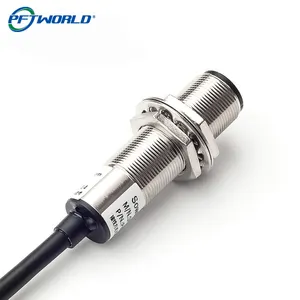
SPH3A0 Series Auto Sensors Positive Reverse Tachometric Transducer GPS Wheel Truck Cement Drum Rotation Speed Meter Sensor


Non Contact Industry Infrared Thermometer -40-2000C Pyrometer IR05B Digital Industrial Thermometedigital Pyrometer





In the fast-paced world of industry, speed measurement is a critical factor that drives efficiency and productivity. From maritime navigation to the rotational speed sensors in printing machines, the tools we use to measure speed have evolved significantly. This article delves into the workings of an inductive tachometer, a device that revolutionizes speed measurements with its magnetic induction principle. We'll explore its advantages, practical applications, and future trends, offering a comprehensive guide to understanding and utilizing this innovative tool.
Speed measurement is a crucial aspect in various industries, and different tools have been used for this purpose. One such tool is used in ships to measure the vessel's relative speed with water. It operates on the principle of Doppler shift in frequency measurement, where the apparent change in frequency received is due to the motion of either the source or observer or both. The speed of the vessel can be determined by measuring the received frequency and knowing the value of transmitted frequency and velocity of sound in seawater.
An inductive tachometer, similar to a magnetic tachometer, measures the rotational speed or angular velocity of a moving object. It operates on the principle of magnetic induction, using the interaction between a moving magnetic field and a stationary electrical conductor to generate an electrical signal proportional to the rotational speed of the object being measured. As the magnet attached to the rotating object passes the stationary coil, the magnetic field lines cut across the coil, inducing an electromotive force in the conductor. This induced force creates a voltage signal whose frequency is directly proportional to the rotational speed.
An inductive tachometer operates on the principle of magnetic induction. It uses the interaction between a moving magnetic field and a stationary electrical conductor to generate an electrical signal proportional to the rotational speed of the object being measured. As the magnet attached to the rotating object passes the stationary coil, the magnetic field lines cut across the coil, inducing an electromotive force. This induced force creates a voltage signal whose frequency is directly proportional to the rotational speed. The signal is processed to remove any noise or interference and is then displayed as a speed value.
Inductive tachometers, a type of inductive sensor, offer several advantages that make them an excellent choice for speed measurements. They can withstand harsh environmental conditions, ensuring durability and longevity. Their installation process is straightforward, making them user-friendly. Inductive tachometers provide predictable results and performance, ensuring reliable speed measurements. They also have a higher switching rate, which contributes to their accuracy. However, it's important to note that their sensing range depends on the type of metal being detected, its shape, size, and the coil size used in the design.
One practical application of an inductive tachometer is on a motorcycle. The user tried to use an inductive tachometer with an integrated coil on plug, wrapping the wire around the coil's tip. However, the tachometer didn't work reliably, especially when the engine got hot. The user sought advice on how to make the inductive tachometer work more effectively, with suggestions including using a spike signal converter or finding a tach output from the ECU. This real-world example illustrates the challenges and potential solutions when using an inductive tachometer for speed measurements.
Rotational speed sensors, including inductive tachometers, are utilized across various industries. In printing and paper machines, they monitor the speed of machine components. In the medical field, a small, turbine-like device working on the same principle is used to diagnose circulatory problems by interpreting the rate of blood flow. The aviation and shipping industries also employ these sensors to monitor the speed of their machinery. The trend is towards the fabrication of tiny chips integrated with sensor bridges, signal amplifiers, and digital interface circuits for contactless RPM measurement.
When choosing the right inductive tachometer, consider factors like RPM readings, compatibility, and durability. For instance, one model provides 16000 RPM readings and works on '2 cylinders 24 stroke engines'. It's made of high-quality materials, ensuring durability. Another model offers a wider range of RPM readings from 0 to 25000 and can be used with chainsaws and other gas devices. A third model reads both hours runtime and the RPM of an engine or chainsaw. It's also user-friendly with a unique display for easy data viewing. All these models are available on Alibaba.com.
The future of speed measurement technology is set to be revolutionized by advancements in data transmission speeds. Recently, a new record was achieved by transmitting a 260 GBaud ultra-high-speed optical signal over 100 km of standard single-mode fiber. This was made possible by a new 256 GSa/s arbitrary waveform generator, which allows R&D teams to create and test transmission systems that operate with symbol rates up to 260 GBaud. This breakthrough paves the way for faster, more efficient networks, indicating a promising future for speed measurement technology.
The inductive tachometer, with its robustness, accuracy, and user-friendly nature, has emerged as a game-changer in the realm of speed measurement. Its applications span across various industries, from aviation to healthcare, demonstrating its versatility. However, the journey doesn't end here. With advancements in data transmission speeds and the development of new technologies, the future of speed measurement is set to be even more exciting. As we continue to push the boundaries of what's possible, the inductive tachometer stands as a testament to our progress and a beacon guiding us towards the future.